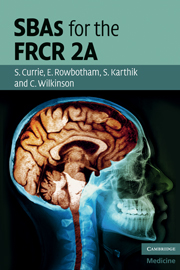Book contents
- Frontmatter
- Contents
- List of contributors
- Preface
- Introduction
- Module 1 Cardiothoracic and vascular
- Module 2 Musculoskeletal and trauma
- Module 3 Gastro-intestinal
- Module 4 Genito-urinary, adrenal, obstetrics & gynaecology and breast
- Module 5 Paediatric
- Module 6 Central nervous and head & neck
- Questions
- Answers
- References
- Index
Questions
Published online by Cambridge University Press: 06 July 2010
- Frontmatter
- Contents
- List of contributors
- Preface
- Introduction
- Module 1 Cardiothoracic and vascular
- Module 2 Musculoskeletal and trauma
- Module 3 Gastro-intestinal
- Module 4 Genito-urinary, adrenal, obstetrics & gynaecology and breast
- Module 5 Paediatric
- Module 6 Central nervous and head & neck
- Questions
- Answers
- References
- Index
Summary
1. A 20 year old male presents with the inability to gaze upwards. CT brain shows moderate hydrocephalus and a rounded mass adjacent to the tectal plate. The mass demonstrates marked homogeneous enhancement and is not calcified. MRI confirms a well-circumscribed, relatively homogeneous mass that is isointense to grey matter on T2-weighted imaging. The mass is hyperintense on contrast-enhanced T1-weighted imaging. What is the most likely diagnosis?
a. Germinoma
b. Teratoma
c. Pineoblastoma
d. Pineocytoma
e. Benign pineal cyst
2. A 40 year old female is investigated for worsening headaches. CT shows a well-defined hyperdense globular lesion within the trigone of the left lateral ventricle. There is intense contrast enhancement. The most likely diagnosis is:
a. Choroid cyst
b. Ependymoma
c. Colloid cyst
d. Meningioma
e. Neurocytoma
3. A 40 year old female presents with bitemporal hemianopia. CT brain shows a large, slightly hyperdense suprasellar lesion. The mass contains several lucent foci and there is bone erosion of the sella floor. There is enhancement post-contrast. T1-weighted MR imaging shows a predominantly isointense mass causing sella expansion and compression of the optic chiasm. The mass contains foci of low and high signal intensity. What is the most likely diagnosis?
a. Craniopharyngioma
b. Meningioma
c. Rathke's cleft cyst
d. Giant internal carotid aneurysm
e. Pituitary adenoma
4. When on call you are asked to perform a CT head scan for a 17 year old male who presents with seizures. He is unable to provide a history. A look on the computer system shows that he has had previous regular abdominal ultrasounds and an echocardiogram as a child.
- Type
- Chapter
- Information
- SBAs for the FRCR 2A , pp. 127 - 140Publisher: Cambridge University PressPrint publication year: 2010



